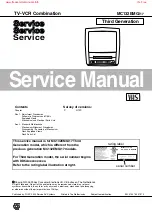
23
VC-A422U
VC-H822U
4-18 ADJUSTMENT OF TAPE DRIVE TRAIN
1. Tape run rough adjustment
1
Remove the cassette housing control assembly.
2
After shortcircuiting between TP803 and TP802 pro-
vided at operation PWB, plug in the power cord.
3
Check and adjust the position of the tension pole.
(See 4-12.)
4
Check and adjust the video search rewind back
tension. (See 4-10.)
5
Connect the oscilloscope to the test point for PB ATR
signal (TP201). Set the synchronism of the oscillo-
scope to EXT. The PB CHROMA signal is to be
triggered by the head switching pulse (TP202).
6
Set the alignment tape (VROATSV) to play. (Put a
500g weight on the cassette tape to prevent lift of
cassette tape.)
Notes:
1. Previously set the tracking control in the center position,
and adjust the ATR signal to maximum with X value
adjustment nut. Thereby the tape run rough adjustment
is facilitated.
2. Especially the outlet side ATR signal must have higher
flatness.
500g
Figure 4-31.
7
Press the tracking button (+), (–) and change the
ATR signal from max to min and from min to max. At
this time make sure that the ATR signal change
nearly parallel.
8
Unless the ATR signal changes nearly parallel, ad-
just the height of supply side and take-up side guide
roller so that the ATR signal changes nearly parallel.
(For ATR signal adjustment procedure refer to Fig-
ure 4-35.)
9
Turn the tilt screw to remove the tape crease at the
fixing guide flange.
Playback the tape and check for tape crease at the
fixing guide flange.
(1) If there is no tape crease
Turn the tilt screw clockwise so that tape crease
appears once at the flange, and then return the tilt
screw so that the crease disappears.
(2) If there is tape crease
Turn counterclockwise the tilt screw so that the
tape crease disappears.
(Reference) If the tilt screw is turned clockwise
crease appears at the lower flange.
Guide roller
Weight of 500g
Cassette Tape
2. Adjustment of A/C head height and azimuth
1
Perform the initial setting of A/C head position by the
method stated in "4-15 Replacement 3".
2
Connect the oscilloscope to the audio output termi-
nal.
3
Using the alignment tape in which 1 kHz linear audio
signal has been recorded, adjust the height screw so
as to get max audio output.
4
Using the alignment tape in which 7 kHz linear audio
signal has been recorded, adjust the azimuth screw
so as to get max audio output.
5
The adjustment of
3
and
4
twice or three times
repeat, and finally adjust
4
.
Figure 4-32.
For X value adjustment
Adjust the X value, turning the gear-
type screwdriver.
Figure 4-33.
3. Tape run adjustment
1
Connect the oscilloscope to PB ATR signal test
point, set oscilloscope sync to EXT, trigger-input the
PB CHROMA signal (head switching pulse).
2
Rough adjustment of X value
Tentatively fix A/C head arm screws
1
and
2
by the
method described in 4-15 "Replacement 3".
Playback the alignment tape (VROATSV) and
shortcircuit between TP801 and TP802. As a result
the auto-tracking is automatically cancelled, so that
the X value adjustment mode is set.
Move the A/C head with the X value adjustment gear
driver (JiGDRiVER-6) by the method shown in Fig-
ure 4-33, and adjust the A/C head so as to get the
maximum ATR signal. (Note: When the A/C head is
adjusted, adjust so that the maximum ATR signal is
obtained nearest the position of initial setting made
in 4-15.)
Summary of Contents for VC-A422U
Page 51: ...VC A422U VC H822U VC A422U VC H822U 52 53 SIGNAL FLOW BLOCK DIAGRAM VC A422U ...
Page 52: ...VC A422U VC H822U VC A422U VC H822U 54 55 SIGNAL FLOW BLOCK DIAGRAM VC H822U ...
Page 53: ...56 VC A422U VC H822U POWER CIRCUIT BLOCK DIAGRAM ...
Page 63: ...72 VC A422U VC H822U M E M O ...
Page 76: ...85 VC A422U VC H822U M E M O ...
















































